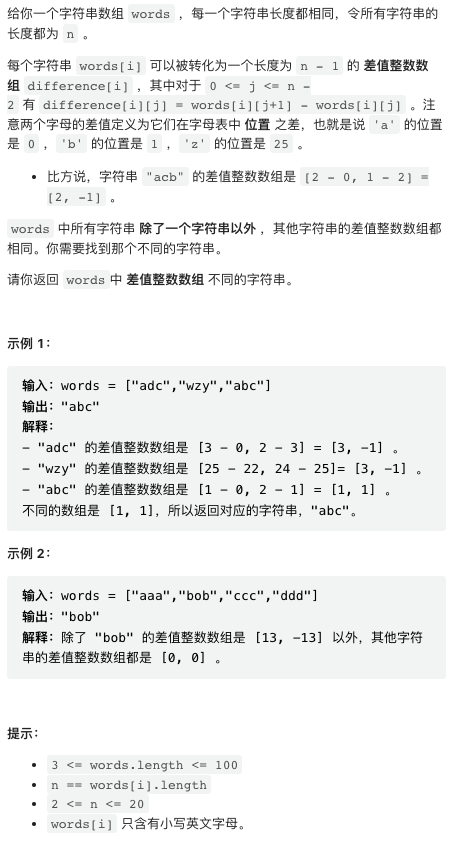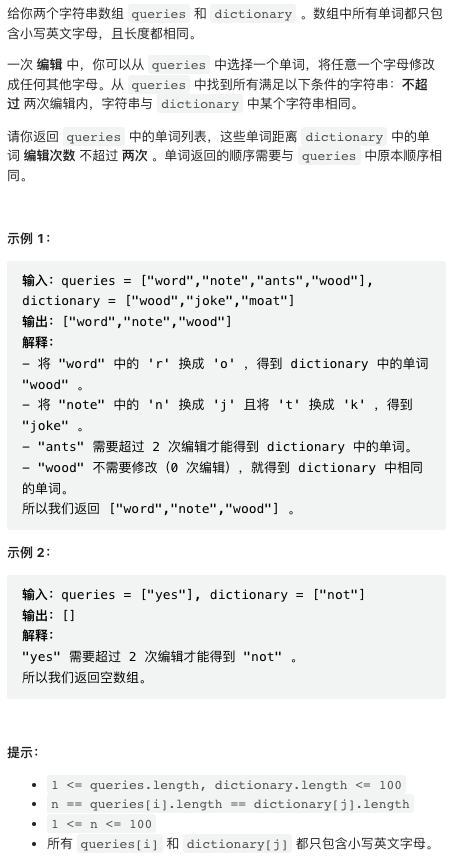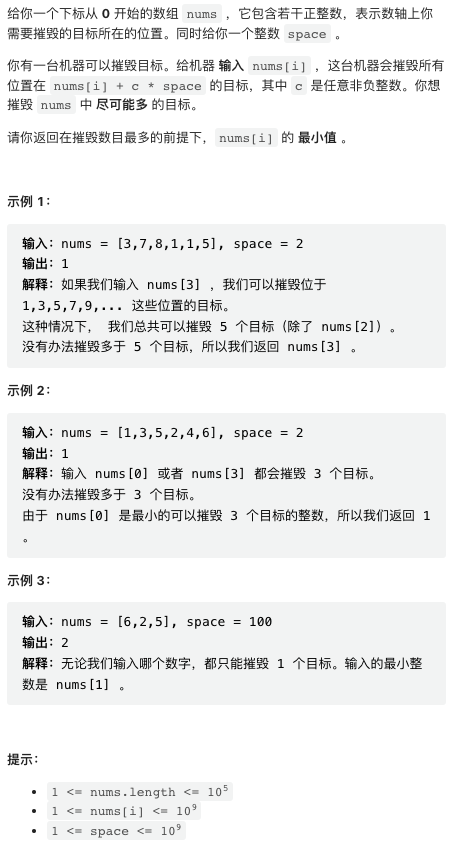双周赛笔记从简,有兴趣可以留言讨论,C++ 强势回归。
1. 差值数组不同的字符串

我承认这个题目把它写成两行不利于阅读。
基本思路是,把每个 word 转换成它对应的 diff 数组并把这个数组转换成字符串(不转换好像也行),然后排序,那个特殊的字符串一定在第一个或者最后一个。
class Solution:
def oddString(self, words: List[str]) -> str:
diff = sorted([(",".join(str(ord(x[j + 1]) - ord(x[j])) for j in range(len(x) - 1)), x) for x in words])
return diff[0][1] if diff[0][0] != diff[1][0] else diff[-1][1]
2. 距离字典两次编辑以内的单词

我上周发现我还是有喜欢 C++ 代码的读者的,所以以后特别适合 C++ 的题目,还是给出 C++ 代码。
这个题目适合暴力解,C++ 可以确保不超时。
class Solution {
public:
vector<string> twoEditWords(vector<string>& queries, vector<string>& dictionary) {
vector<string> res;
for(auto& q: queries) {
for(auto& w: dictionary) {
int diff = 0;
for(int i = 0; i < q.size(); i++) {
diff += q[i] != w[i];
}
if(diff <= 2) {
res.push_back(q);
break;
}
}
}
return res;
}
};
3. 摧毁一系列目标

偏数学。某个输入对应的所有被摧毁的目标是关于 space 同余的,因为 t % space= nums[i] % space + c * space % space = nums[i] % space.
所以,我们可以先统计一下每个余数对应的目标数量,要求的输入就是余数是目标数量最大的余数的输入中最小的一个。
class Solution:
def destroyTargets(self, nums: List[int], space: int) -> int:
nums.sort()
# 所有的余数
mod = [x % space for x in nums]
# 余数 count
cnt = collections.Counter(mod)
# count 最多的余数的 count 数量
max_cnt = max(cnt.values())
for m, x in zip(mod, nums):
if cnt[m] == max_cnt:
return x
return -1
4. 下一个更大元素 IV

人老了,这种难度的题目都需要使用 C++ 专有数据结构了。
这个题目明显跟单调栈有点关联,但想要构建出基于栈的题解并不是那么容易。反而基于链表或者有序 map 的解法比较容易理解。
这类题目一种常常会有帮助的思路是考虑从大到小求解。我们考虑使用一个 map, key 是数字原本的 index, 然后将所有数字从大到小加入这个 map, 则「下一个更大元素」很容易使用指针运算找到。特别注意,下一个更大元素是严格大于而不是大于等于,因此需要特殊处理一下相等的数字。
class Solution {
public:
vector<int> secondGreaterElement(vector<int>& nums) {
int n = nums.size();
// 将原数组逆序排序,并保留原本的 index
vector<pair<int, int>> pairs(n);
for(int i = 0; i < n; i++) {
pairs[i] = {nums[i], i};
}
sort(pairs.begin(), pairs.end());
reverse(pairs.begin(), pairs.end());
vector<int> res(n);
map<int, int> vals; // <index, val>
// 下面两行是特殊写法,可以保证 i, j 指向一个「相等区间」的 begin, end
for(int i = 0, j = 0; i < n; i = j) {
while(j < n and pairs[j].first == pairs[i].first) j++;
for(int k = i; k < j; k++) {
// 第一个更大元素
auto it = vals.lower_bound(pairs[k].second);
// 第二个更大元素
if(it != vals.end()) it++;
res[pairs[k].second] = it != vals.end() ? it->second : -1;
}
// 把这个区间加入到 map 中
for(int k = i; k < j; k++) {
vals[pairs[k].second] = pairs[k].first;
}
}
return res;
}
};
但有序 map 是一种 C++ 特有的数据结构,在 python 中难以实现这个解法。
讨论区大佬们给出了双单调栈写法,记录在这里。这个解法的重点在于,第一个单调栈 s 跟一般的单调栈相似,可以认为它记录的是「没有找到下一个更大元素的数」。这个解法的精妙之处在于,s 出栈之后,又入栈了第二个单调栈 t, t 中保存的相当于「没有找到第二个更大元素的数」。特别注意从 s 转移到 t 时需要保持原顺序,不要因为出栈操作变成逆序。
这类解法如果仔细去思考是可以构建出来的,但总体来说在实战中并不推荐,因为首先其应用范围特别窄,只适合特定题目,其次其操作过于复杂,难设计也难实现。
# https://leetcode.cn/problems/next-greater-element-iv/solution/by-endlesscheng-q6t5/
class Solution:
def secondGreaterElement(self, nums: List[int]) -> List[int]:
ans, s, t = [-1] * len(nums), [], []
for i, x in enumerate(nums):
while t and nums[t[-1]] < x:
ans[t.pop()] = x
j = len(s) - 1
while j >= 0 and nums[s[j]] < x:
j -= 1
t += s[j + 1:]
del s[j + 1:]
s.append(i)
return ans